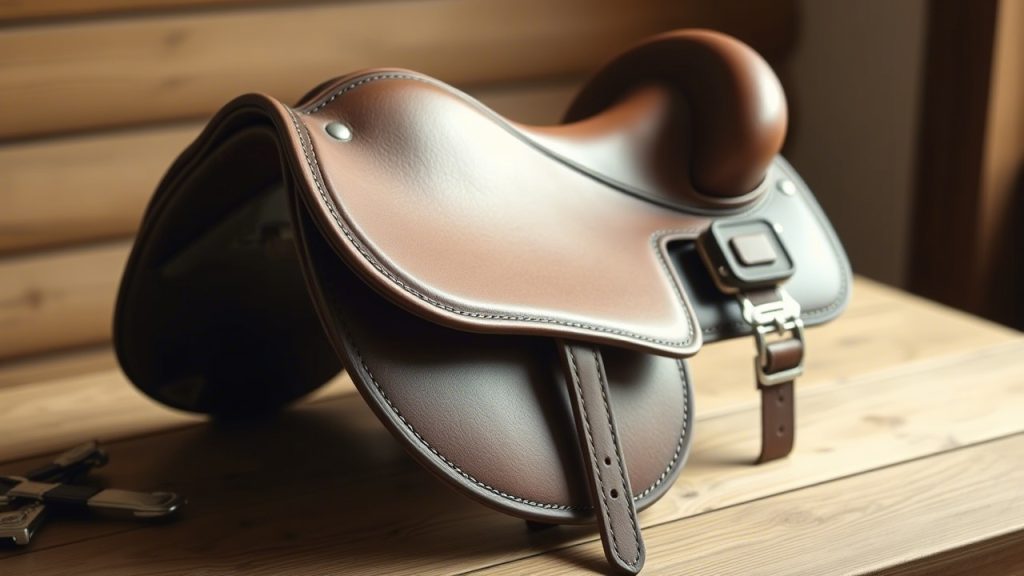Horseback riding is an exhilarating sport that demands balance, control, and confidence. However, slipping in the saddle can disrupt your ride, compromise safety, and shake your confidence. Whether you’re navigating a spirited trot, a challenging trail, or a competitive arena, a saddle that prevents slipping is essential for a secure and enjoyable experience. The good news? You can significantly reduce slipping in just a weekend by choosing the right saddle and accessories. We’ll explore the 9 best horse riding saddles to prevent slipping in a weekend, offering practical solutions to keep you steady in the saddle.
This blog post is packed with expert insights, actionable tips, and saddle recommendations to help riders of all levels stay secure. From saddle fit to grip-enhancing features, these ideas are designed to deliver quick results, ensuring you ride with confidence by Monday. Let’s dive in and discover how to stay firmly seated!
Why Preventing Slipping Matters
Slipping in the saddle isn’t just an inconvenience—it can lead to serious issues for both rider and horse. For the rider, slipping can cause loss of balance, falls, or muscle strain from overcompensating. For the horse, an unstable rider can create uneven weight distribution, leading to discomfort or behavioral problems. A saddle that prevents slipping:
- Enhances rider stability and control.
- Reduces the risk of falls and injuries.
- Promotes clear communication with your horse.
- Improves confidence for more enjoyable rides.
By implementing the following nine saddle ideas, you can address slipping and achieve a secure seat in just a weekend. Let’s get started!
1. Schedule a Professional Saddle Fitting
A properly fitted saddle is the foundation of a secure seat. An ill-fitting saddle can cause the rider to slide forward, backward, or sideways, increasing the risk of slipping.
How to Do It:
- Hire a certified saddle fitter registered with the Society of Master Saddlers (SMS).
- Request a static and dynamic fitting to assess the saddle on your horse at rest and in motion.
- Ensure the saddle’s seat size, flap length, and tree width suit your body and riding style.
Why It Prevents Slipping:
A well-fitted saddle positions your pelvis correctly, keeping you centered and reducing unwanted movement. Proper fit can eliminate slipping issues immediately.
Pro Tip: Schedule fittings every 6–12 months to account for changes in your horse’s conformation or your riding technique.
2. Choose a Saddle with a Deep Seat
Saddles with deep seats, such as dressage or endurance models, cradle the rider’s pelvis, providing a secure position that minimizes slipping.
How to Do It:
- Select a saddle with a deep, contoured seat, like the Albion SLK Ultima Dressage Saddle.
- Ensure the seat size matches your body for optimal support.
- Test the saddle during a short ride to confirm stability.
Why It Prevents Slipping:
A deep seat anchors you in place, preventing sliding during sudden movements or fast gaits, with noticeable results in days.
Pro Tip: Pair with a riser pad to fine-tune saddle balance if needed.
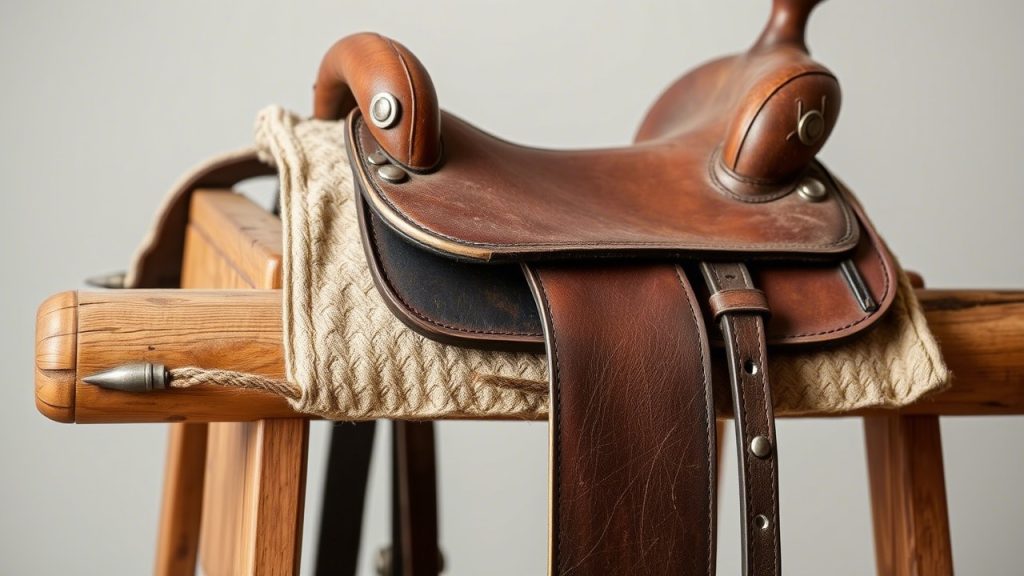
3. Opt for a Saddle with Non-Slip Materials
Saddles made from grip-enhancing materials, such as suede or textured synthetic fabrics, provide extra traction to keep you in place.
How to Do It:
- Choose saddles with suede seats or microfiber panels, like the Collegiate Lectern General Purpose Saddle.
- Ensure the material is durable and easy to clean.
- Avoid overly slick leather saddles if slipping is a concern.
Why It Prevents Slipping:
Non-slip materials increase friction between you and the saddle, reducing sliding during dynamic rides.
Pro Tip: Clean synthetic saddles with water first to maintain their grip and avoid greasy residue.
4. Add Non-Slip Grip Pads
Non-slip grip pads are an affordable and quick way to enhance saddle traction, stabilizing your seat and legs.
How to Do It:
- Attach grip pads to the saddle’s flaps or seat, using materials like silicone or suede.
- Choose pads like the ECP Non-Slip Saddle Pad for secure adhesion.
- Test during a ride to ensure comfort and effectiveness.
Why It Prevents Slipping:
Grip pads provide immediate traction, allowing you to relax your muscles and stay centered, reducing slipping within hours.
Pro Tip: Keep pads clean and free of dirt to maintain their grip.
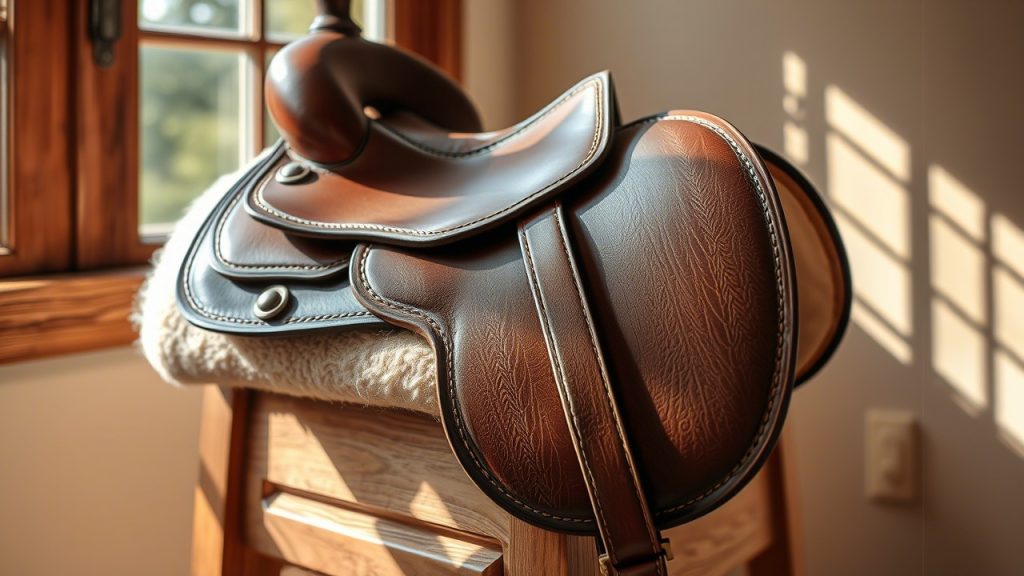
5. Select a Saddle with Adjustable Stirrup Bars
Adjustable stirrup bars allow you to customize stirrup placement, aligning your legs and hips to prevent slipping caused by poor leg positioning.
How to Do It:
- Choose saddles with adjustable stirrup bars, like the Bates All Purpose Saddle.
- Adjust the bars to position stirrups under your hips for a balanced seat.
- Work with a fitter to ensure proper alignment.
Why It Prevents Slipping:
Correct stirrup placement stabilizes your legs, reducing the tendency to slide forward or backward.
Pro Tip: Experiment with stirrup length during a short ride to find the most secure position.
6. Use a Saddle with a Balanced Tree
A balanced saddle tree ensures even weight distribution, preventing the saddle from tipping and causing rider slipping.
How to Do It:
- Select a saddle with a tree designed for your horse’s back shape, like the Wintec Pro Dressage Saddle.
- Confirm tree width and balance with a fitter.
- Check saddle alignment by placing it on your horse without a pad.
Why It Prevents Slipping:
A balanced tree keeps the saddle level, maintaining your centered position and reducing slipping risks.
Pro Tip: Avoid saddles with twisted or uneven trees, which can exacerbate slipping.
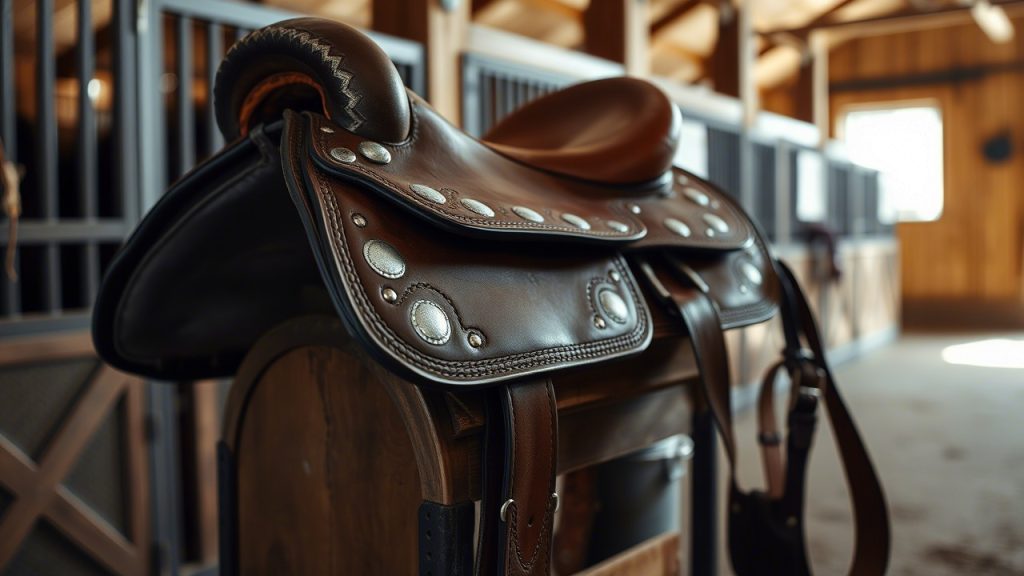
7. Incorporate a Padded Seat Saver
A padded seat saver adds cushioning and grip, enhancing comfort and stability to prevent slipping during rides.
How to Do It:
- Choose a seat saver with gel or foam padding, like the Toklat CoolBack Seat Saver.
- Ensure it fits securely over the saddle’s seat without shifting.
- Test for comfort and grip during a short ride.
Why It Prevents Slipping:
Seat savers provide extra traction and cushioning, anchoring your pelvis and reducing sliding.
Pro Tip: Combine with posture exercises to maximize stability.
8. Try a General Purpose Saddle for Versatility
General purpose (GP) saddles offer a moderately deep seat and flexible design, making them ideal for riders who need stability across disciplines.
How to Do It:
- Select a GP saddle with a supportive seat, like the Thorowgood T4 Cob GP Saddle.
- Ensure the saddle fits your horse to avoid compensatory slipping.
- Test for comfort during various gaits.
Why It Prevents Slipping:
GP saddles provide a balanced, secure seat, reducing slipping during diverse riding activities.
Pro Tip: Adjust flap position to suit your leg length for added stability.
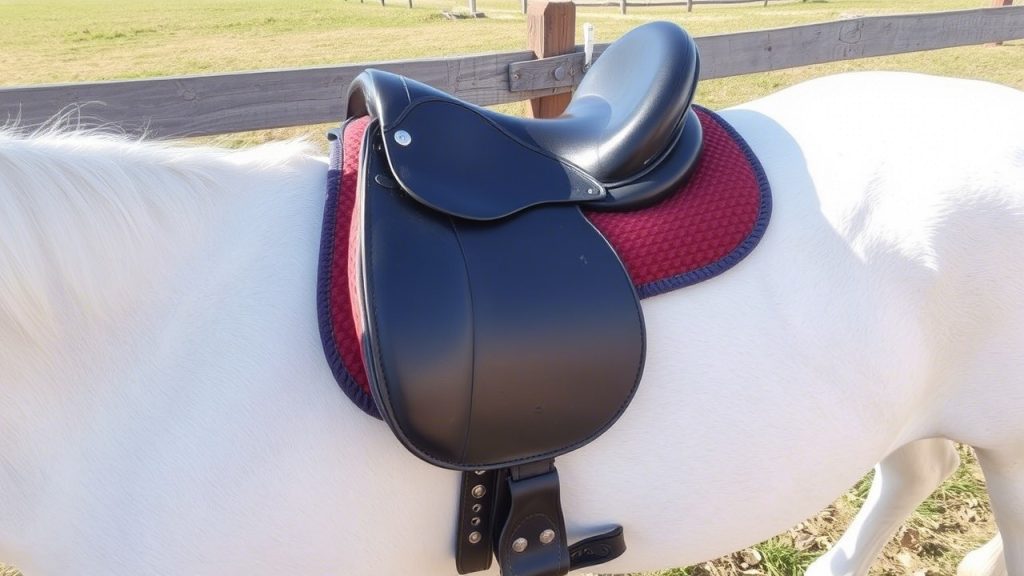
9. Invest in a Saddle with Knee and Thigh Blocks
Saddles with knee and thigh blocks provide additional support, guiding your legs into a secure position to prevent slipping.
How to Do It:
- Choose saddles with adjustable or fixed blocks, like the Pessoa Gen-X Elite Saddle.
- Ensure blocks are positioned to support your natural leg alignment.
- Test during a ride to confirm comfort and stability.
Why It Prevents Slipping:
Blocks anchor your legs, reducing sliding during sudden movements or high-speed gaits.
Pro Tip: Start with smaller blocks if you’re new to using them to avoid discomfort.
Additional Strategies to Prevent Slipping
To maximize your saddle’s slip-prevention capabilities, consider these complementary strategies:
Optimize Saddle Flocking
Flocking inside saddle panels affects saddle balance. Compressed or uneven flocking can cause the saddle to shift, leading to rider slipping.
How to Do It:
- Have a fitter adjust flocking to match your horse’s back contours.
- Avoid over- or under-flocking to maintain even contact.
- Schedule flocking checks every 6 months.
Why It Helps:
Proper flocking keeps the saddle stable, reducing slipping caused by an unbalanced seat.
Practice Core-Strengthening Exercises
A strong core enhances your ability to stay centered in the saddle, reducing the likelihood of slipping.
How to Do It:
- Try yoga or Pilates to build core strength and improve balance.
- Practice “riding on your thigh” to distribute weight evenly.
- Stretch before rides to release tension.
Why It Helps:
A strong core stabilizes your seat, complementing the saddle’s slip-prevention features.
Maintain Your Saddle Regularly
A well-maintained saddle ensures consistent fit and grip, preventing slipping due to wear or damage.
How to Do It:
- Clean and condition leather saddles to maintain suppleness and grip.
- Inspect for loose stitching or worn materials.
- Store in a dry, temperature-controlled environment.
Why It Helps:
A maintained saddle provides reliable traction and fit, reducing slipping risks.
Use a High-Quality Saddle Pad
A saddle pad with anti-slip properties can enhance stability and prevent saddle movement.
How to Do It:
- Choose pads with silicone grips or sheepskin linings, like the Mattes Eurofit Saddle Pad.
- Ensure the pad fits both saddle and horse to avoid shifting.
- Clean pads regularly to maintain grip.
Why It Helps:
Anti-slip pads stabilize the saddle, reducing rider slipping during dynamic rides.
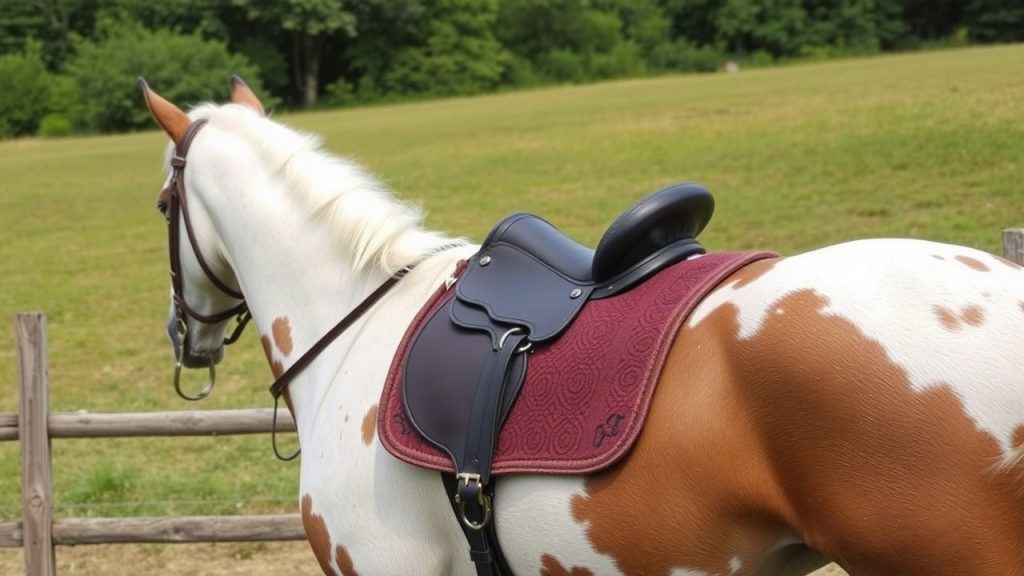
How to Implement These Ideas in a Weekend
To prevent slipping by Monday, follow this weekend plan:
- Friday Evening: Schedule a professional saddle fitting to assess your current saddle’s fit and stability.
- Saturday Morning: Research and test saddles with deep seats, non-slip materials, or knee blocks.
- Saturday Afternoon: Purchase non-slip grip pads and a padded seat saver, and attach them to your saddle.
- Saturday Evening: Adjust stirrup bars and flocking with a fitter’s guidance for optimal balance.
- Sunday Morning: Test a GP or adjustable saddle and practice core exercises to enhance stability.
- Sunday Afternoon: Clean and maintain your saddle, and add an anti-slip saddle pad.
- Sunday Evening: Go for a short ride to confirm reduced slipping and enjoy your secure seat.
By combining these strategies, you’ll achieve a stable, slip-free ride in just a weekend, boosting your confidence and safety.
Why These Saddles Work So Quickly
These saddles and accessories address slipping at its core: instability caused by poor fit, lack of grip, or improper rider positioning. A professional fitting ensures the saddle aligns with your body and horse, while deep seats and grip pads provide immediate traction. Adjustable features and knee blocks stabilize your position, and complementary exercises reinforce your balance. Together, these elements create a secure riding setup that delivers results in days, making your weekend efforts highly effective.
Common Causes of Slipping and How Saddles Help
Understanding why slipping happens can help you choose the right saddle:
- Poor Saddle Fit: Causes the saddle to shift, destabilizing the rider. A professional fitting and balanced tree fix this.
- Slick Materials: Smooth leather reduces traction. Non-slip materials and grip pads increase friction.
- Incorrect Stirrup Placement: Misaligned stirrups throw off balance. Adjustable stirrup bars correct leg positioning.
- Weak Core Strength: Leads to compensatory gripping. Core exercises and supportive saddles stabilize your seat.
- Sudden Horse Movements: Jarring gaits increase slipping. Deep seats and knee blocks anchor you in place.
The saddles recommended here target these issues directly, ensuring a secure ride in minimal time.
FAQs About Horse Riding Saddles and Preventing Slipping
1. How do I know if my saddle is causing me to slip?
If you slide forward, backward, or sideways, or feel unstable, your saddle may not fit properly or lack grip. A fitter can confirm.
2. Are deep-seat saddles better for preventing slipping?
Yes, deep seats cradle your pelvis, providing a secure position that reduces slipping during dynamic rides.
3. Can grip pads really prevent slipping?
Non-slip grip pads increase traction, stabilizing your seat and legs to reduce sliding instantly.
4. How often should I check my saddle’s flocking to prevent slipping?
Check flocking every 6 months or after changes in your horse’s shape to maintain saddle balance and stability.
5. Do adjustable stirrup bars help with slipping?
Yes, they allow you to align stirrups with your hips, improving leg stability and reducing slipping.
6. What materials are best for slip-resistant saddles?
Suede, textured synthetics, or microfiber provide grip, reducing slipping compared to smooth leather.
7. Can a seat saver reduce slipping?
A padded seat saver adds cushioning and grip, anchoring your pelvis to prevent sliding.
8. How does rider posture affect slipping?
Poor posture causes imbalance, increasing slipping. Core exercises and supportive saddles promote a stable seat.
9. How much does a professional saddle fitting cost?
Costs range from $100–$300, depending on the fitter and region. Contact SMS-registered fitters for quotes.
10. Can I prevent slipping without buying a new saddle?
Yes, adding grip pads, a seat saver, and an anti-slip pad, plus adjusting flocking, can reduce slipping with your current saddle.
Conclusion
Slipping in the saddle can undermine your confidence and safety, but it’s a problem you can solve quickly. By choosing one of the 9 best horse riding saddles to prevent slipping in a weekend, you can transform your riding experience in just days. From professional fittings to grip-enhancing pads and deep-seat saddles, these solutions are practical, effective, and fast-acting.
Ready to ride with stability? Start with a saddle fitting, add non-slip accessories, and practice core exercises. Your horse will appreciate the balanced ride, and you’ll love the confidence of a secure seat. Share your favorite slip-prevention tips in the comments below, and happy riding!

